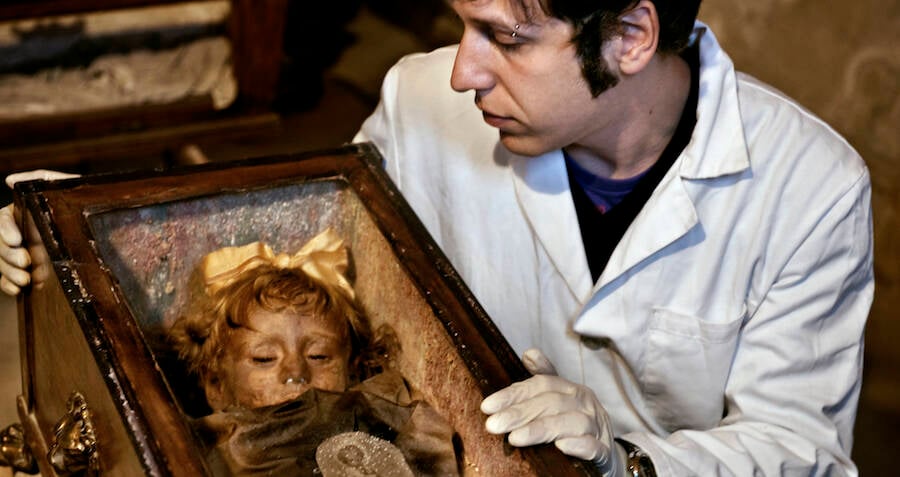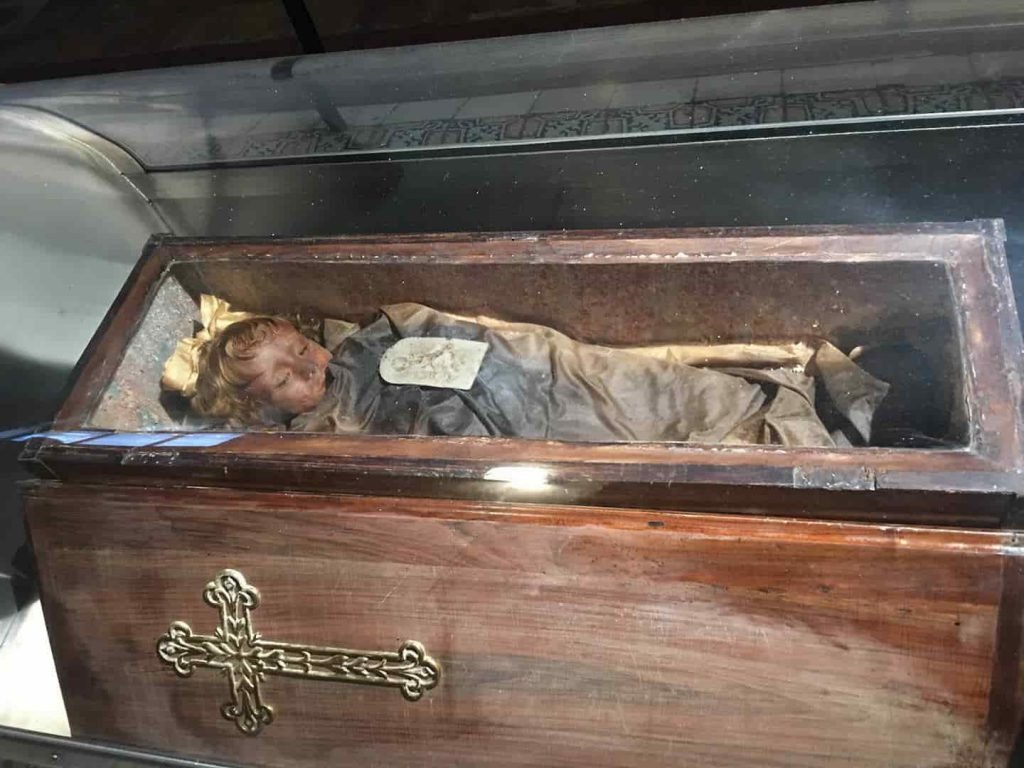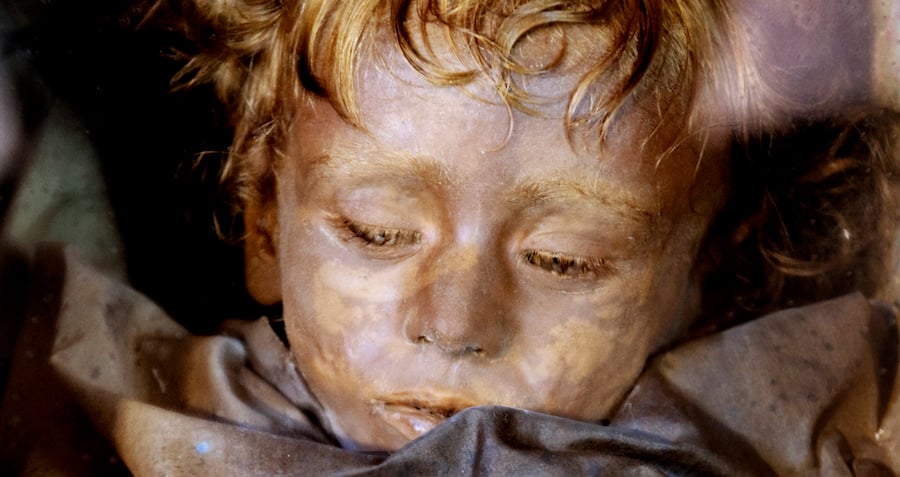In the silent corridors of Palermo’s Capuchin Catacombs lies one of the world’s most extraordinary mysteries. Among thousands of preserved bodies resting in this underground labyrinth, one figure stands apart—not for grandeur, but for the gentle stillness of a little girl. Her name was Rosalia Lombardo, and though she passed away more than a century ago, she continues to capture the imagination of scientists, historians, and visitors alike. Known as the “Sleeping Beauty” of Palermo, her preservation is so lifelike that many believe she is merely resting, waiting to awaken.
A Tragic Loss in 1920

Rosalia Lombardo was born in Palermo, Sicily, in 1918. Like many children of her time, her life was touched by the difficulties of post-World War I Europe. In 1920, at just two years old, she passed away from pneumonia, leaving her family devastated. Her father, Mario Lombardo, heartbroken at the loss of his beloved daughter, sought a way to preserve her memory forever. He turned to the expertise of Alfredo Salafia, an embalmment specialist in Palermo, whose methods would later astonish the world.
The Art of Preservation

Salafia’s techniques were a closely guarded secret during his lifetime. Unlike traditional mummification, which often left remains desiccated and rigid, his process gave Rosalia the appearance of eternal sleep. Her delicate features—rosy cheeks, braided hair, and tiny eyelashes—remained intact in a way unseen in most preserved remains. For decades, the formula baffled scientists. Only in the 2000s did researchers uncover Salafia’s notes, revealing a mixture of formalin, alcohol, zinc salts, and salicylic acid. This unique blend halted decomposition while giving her body a remarkable lifelike quality.
The use of zinc salts, in particular, was revolutionary. While other methods merely slowed decay, zinc created a form of petrification, lending Rosalia’s body its enduring structure. Combined with the controlled environment of the catacombs, this formula ensured that she would appear unchanged for generations.
The Mystery of the “Open Eyes”

Perhaps the most haunting aspect of Rosalia’s story is the illusion of her eyes. Visitors often report that her eyes seem to slowly open and close, as if she is blinking or stirring from sleep. Photographs taken over decades appear to confirm this phenomenon—her gaze seems different in each image, ranging from fully closed to faintly open.
For years, this fueled speculation. Some believed it was evidence of the supernatural, while others suggested it was a trick of light. Scientific analysis eventually provided an explanation: Rosalia’s eyelids were never fully closed at the time of embalming. Because of the way light enters the catacombs through small windows and shifts throughout the day, shadows fall differently across her face, creating the impression of movement. In reality, her eyes remain in the same position, but the play of light makes them appear eerily alive.
Why Rosalia Captures the World’s Imagination

Rosalia Lombardo’s story touches people for many reasons. On one level, it is a tale of a father’s grief and love—his desperate wish to keep his daughter close, even beyond death. On another, it represents a scientific marvel, a display of human ingenuity in preservation techniques that still astonishes modern researchers. But perhaps most of all, it is the illusion of life that captivates us. Looking at Rosalia, we do not see a historical artifact; we see a child with flushed cheeks, peaceful expression, and almost dreaming eyes.
Her presence blurs the line between past and present, between memory and eternity. Visitors to the Capuchin Catacombs often describe feeling a deep emotional connection, as though they are looking not at someone who lived a century ago, but at someone who still inhabits the moment.
The Capuchin Catacombs: A City of the Dead

To understand Rosalia’s significance, it helps to know the setting where she rests. The Capuchin Catacombs of Palermo are one of the most unusual burial sites in the world. Dating back to the 16th century, the catacombs house thousands of monks, nobles, and citizens who were preserved using various techniques. What began as a simple monastic cemetery expanded into a cultural phenomenon, where families could visit their loved ones long after their passing.
Within this unique tradition, Rosalia’s presence stands out. While many other preserved bodies show the effects of time, hers remains astonishingly lifelike. She rests in a small glass coffin, placed in a chapel where sunlight sometimes glints across her face, reinforcing the illusion of quiet slumber.
A Scientific Window Into the Past

Rosalia Lombardo is not only a cultural icon but also a subject of serious scientific study. Researchers have used X-rays and CT scans to examine her body, uncovering remarkable details: her organs remain intact, her skeletal structure preserved, and even her tiny bowels and brain still distinguishable. This level of preservation is almost unparalleled, providing valuable insights into both early 20th-century embalming techniques and the possibilities of long-term human preservation.
The study of Rosalia also sheds light on broader historical practices. Her embalming represents a transition between older traditions of preservation and modern scientific methods. By examining her, scientists not only unlock the secrets of Alfredo Salafia’s work but also gain a deeper understanding of how societies across time have sought to honor their dead.
Myth, Mystery, and Memory

Rosalia’s lifelike appearance has inspired countless myths. Some claim she is merely sleeping. Others suggest she opens her eyes to watch over visitors. These stories, while not grounded in scientific fact, reflect the profound emotional impact she has on those who see her. Unlike statues or portraits, she is a real person, preserved in extraordinary detail, her presence both comforting and unsettling.
In many ways, Rosalia has become a symbol of timeless innocence. Her small body, perfectly at rest, stands in stark contrast to the often harsh and fleeting nature of life. Through her, people find a reminder of both the fragility of human existence and the enduring power of memory.
Preserving Rosalia for Future Generations

In recent years, efforts have been made to ensure Rosalia’s continued preservation. Exposure to light, humidity, and temperature fluctuations could eventually threaten her condition. To counter this, conservators placed her in a hermetically sealed glass coffin filled with nitrogen, minimizing the risk of decay. These precautions demonstrate how important she has become not just to Sicily but to global cultural heritage.
Tourism to the Capuchin Catacombs remains steady, with many visitors traveling specifically to see Rosalia. While some come for scientific curiosity, others are drawn by the emotional resonance of her story. Museums, documentaries, and books have all featured her, keeping her memory alive far beyond the walls of Palermo.
What Rosalia Teaches Us
At its heart, Rosalia’s story is about more than preservation. It is about how humans confront loss and remember those they love. Her father’s choice ensured that his daughter’s face would never be forgotten, and in doing so, he inadvertently gave the world a timeless wonder. Through Rosalia, we are reminded that science and love can intertwine in unexpected ways, creating legacies that last for centuries.
Her eyes—whether open, closed, or somewhere in between—continue to invite reflection. They urge us to consider how we preserve memory, how we face mortality, and how stories live on long after the people who inspire them are gone.
Conclusion: The Eternal Gaze of Rosalia Lombardo
Rosalia Lombardo rests in a quiet chamber beneath Palermo, yet her presence speaks across the world. She is more than a mummy; she is a mystery, a work of art, a scientific case study, and above all, a child remembered with extraordinary devotion. Her preserved features challenge our understanding of life, death, and memory, while her story continues to inspire wonder and compassion.
Whether one sees her as “Sleeping Beauty,” a marvel of embalming science, or simply a beloved daughter frozen in time, Rosalia Lombardo remains one of history’s most compelling enigmas. A century after her passing, she still gazes at us—inviting reflection, curiosity, and awe.
